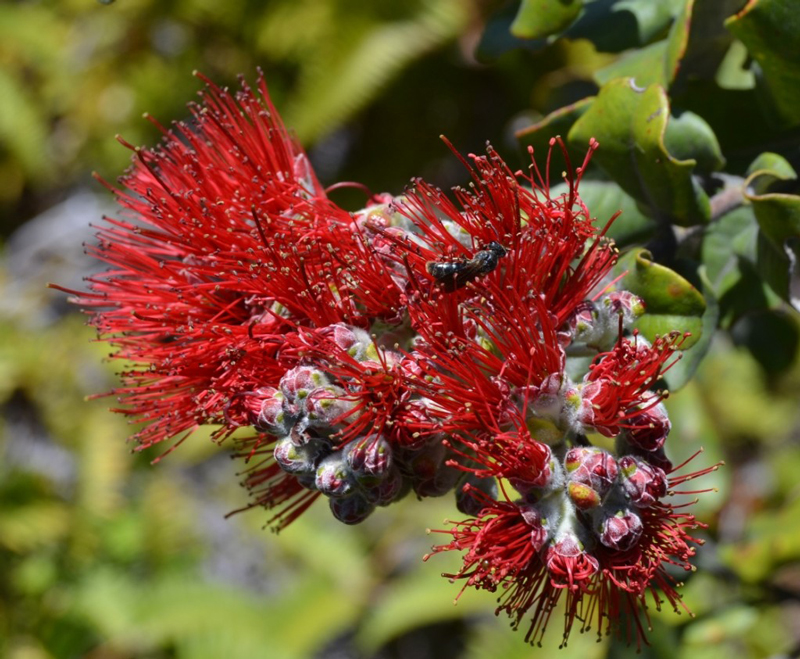This summer, I had the pleasure of visiting Hawai‘i with my family. What a wonderful vacation! Beautiful beaches, kayaking, sea turtles, fresh pineapple, fabulous tropical gardens, volcanoes—but I also went in hunt of bees. I found bees in the gardens of the first place we stayed. But the carpenter bees and honey bees were not what I was seeking. No, I was in pursuit of Hawai‘i’s native bees, the yellow-faced bees in the genus Hylaeus.
My first encounter with one of these bees was in Ho‘omaluhia Botanical Garden on the island of O‘ahu. There it was on the yellow flowers of creeping-oxeye (Sphagneticola trilobata). It flew away before I could get down to ground level with my camera, but it was unmistakably a bee. The second place I saw one was on the Big Island, in Volcanoes National Park. It was foraging in the red flowers of ohi’a lehua (Metrosideros polymorpha) and this time I did get photos, though admittedly not great ones.

Spotting these bees took some dedication, but I was so glad that I did see them. There are more than forty species of yellow-faced bees in Hawai‘i. None of them are found anywhere else in the world and some are found in only a handful of places in the islands. Sadly, these bees are disappearing. A century ago, naturalist Robert Perkins called Hawaiian yellow-faced bees “almost the most ubiquitous of any Hawaiian insects.” More recent surveys by biologist Karl Magnacca have demonstrated that seven species are in imminent danger of going extinct.
Six years ago, the Xerces Society submitted a series of petitions to the U.S. Fish and Wildlife Service requesting protection for these seven: Hylaeus anthracinus, Hylaeus longiceps, Hylaeus assimulans, Hylaeus facilis, Hylaeus hilaris, Hylaeus kuakea, and Hylaeus mana.
Today, great news! The FWS proposed that these seven species of Hawaiian yellow-faced bees be listed as endangered under the Endangered Species Act. When the proposed rule is finalized, these will be the first bees to gain federal protection in the United States (which in itself is remarkable given the barrage of threats facing bees elsewhere in the U.S.).
Hawai‘i’s yellow-faced bees face many threats, from the loss of habitat due to land conversion, development, and recreation (especially in coastal and lowland areas) to the negative impacts of nonnative species, such as wild pigs, bigheaded ants, and invasive plants. Climate change also poses a threat to small populations of these bees. Conservation of these bees will require the active management of natural areas where populations are known to exist.
Despite their small size, Hawaiian yellow-faced bees are extremely important. They are critical pollinators of many endangered native Hawaiian plants and the decline of these bees could lead to the extinction of the plants that rely upon them. Recognizing the endangerment of numerous native Hawaiian plant species, the Service has granted Endangered Species Act protection to over 300 Hawaiian plants, and proposed listing for an additional 39 species today. Protection of these imperiled pollinators will benefit both the bees and the rare plants that they pollinate.
I’m not sure when I am able to return to Hawai‘I, but I will certainly make a point of tracking down some more yellow-faced bees.



